[Update on 16th October 2023] The values of new light ones of ‘Ebenholz NCT VII’ have been added.
[Update on 13th October 2023] The values of ‘Rosewood NCT V’ and ‘Ebenholz NCT V’ have been updated.
1. INTRODUCTION
Stiga has produced many legendary table tennis blades for long time. However, at the beginning of 21th century the situation of Stiga was not that good. Although Stiga had many legendary blades such as Clipper in its blade range, there wasn’t any blade that can be an image leader. On the contrary, the competitors such as Butterfly and Donic were launching many new blades with more refined and advanced look every year. Something new was required for Stiga to recover its image as the leader of table tennis blade.
Under that situation, finally Stiga introduced game changers in 2009. Before it, Stiga once tried modern and refined look with some new blades. But, the result wasn’t that good. Maybe for that reason, Stiga decided to ‘return’ or ‘go further’ to traditional image. And, instead of trying modern and refined look, Stiga tried to utilize the high class appearance of special wood materials. The result was the introduction of brand-new ‘hardwood’ series.
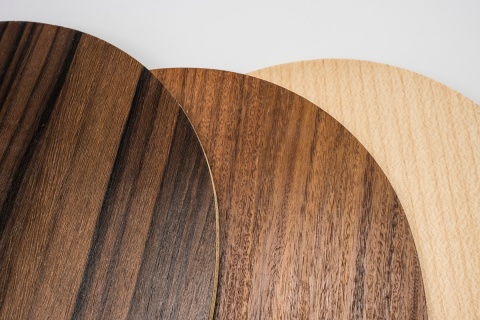
To understand the characteristics of six hardwood blades, the performance indices will be utilized. Concerning the detail of four performance indices, please refer to following articles in ‘Background’ section :
– Performance indices : the way to evaluate blade by measurement
– The example of comparison by performance indices
Note : In fact, Maplewood NCT V and Maplewood NCT VII have already been discontinued, and are currently not on Stiga catalog. However, for total understanding on Hardwood series, those two models will be included in comparison.
2. COMPARISON BY PERFORMANCE INDICES
The 6 modesl of Stiga Hardwood series are as follows:
- Ebenholz NCT V (avg.weight = 83.8g) : 5-ply wood blade with ebony top layer.
- Ebenholz NCT VII – Heavy (avg.weight = 101.6g) : 7-ply wood blade with ebony top layer.
- Ebenholz NCT VII – Light (avg.weight = 91.3g) : 7-ply wood blade with ebony top layer. (Newly measured and added to this article in 2023)
- Rosewood NCT V (avg.weight = 90.8g) : 5-ply wood blade with rosewood top layer.
- Rosewood NCT VII (avg.weight = 93.7g) : 7-ply wood blade with rosewood top layer.
- Maplewood NCT V (avg.weight = 89.0g) : 5-ply wood blade with maple top layer. Discontinued.
- Maplewood NCT VII (avg.weight = 94.6g) : 7-ply wood blade with maple top layer. Discontinued.
All six models are of course pure wood blades without any artificial materials except for Nano Crystal powder that is mixed in glue between wood layers. Three kinds of special woods are used for top layer, and each special wood has two versions – 5-ply wood and 7-ply wood.

For better understanding, 5 blades will be compared with 6 models of Hardwood series.
- Stiga Allround Classic (avg.weight = 84.3g) : Basic reference blade whose all indices are 1.00.
- Stiga Offensive Classic (avg.weight = 79.9g) : Traditional Stiga offensive blade which had used by Chinese National Team.
- Butterfly Korbel (avg.weight = 88.7g) : Very popular 5-ply wood offensive blade that has been used by many top players.
- Stiga Clipper CR (avg.weight = 96.8g) : The representative of fast 7-ply wood blade. Heavy ones.
- Butterfly Timo Boll Spirit (avg.weight = 90.6g) : Same as Timo Boll ALC except for Graphic Design. The most famous ‘ALC’ blade.
First, let’s see the Elasticity Indices to examine the performance of Hardwood series. Fig.03 shows the comparison graph by Elasticity Indices.
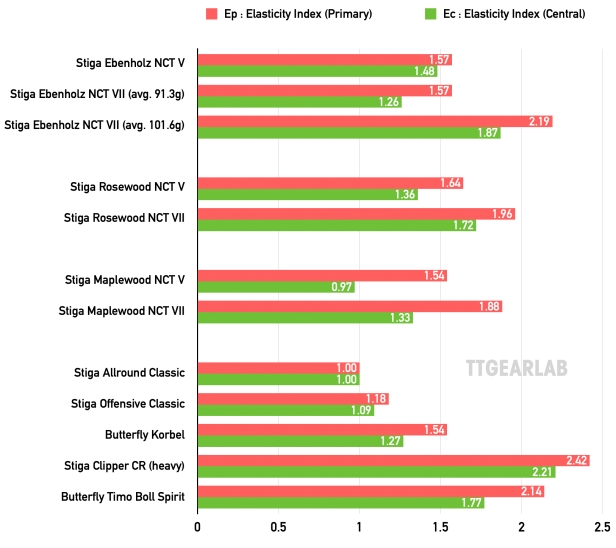
Fig.03 Comparison by Elasticity Indices
Ep is directly concerned with the rebound speed of blade. One usual prejudice is that 7-ply wood blade is faster than 5-ply wood blade. But, that prejdice is not always truth. There are so many cases that the Ep of a 5-ply blade is higher than, or same as that of a 7-ply wood blade.
(Note : New data for lighter Ebenholz NCT VII has been added. New lighe ones weighs 91.3g while heavy ones weighs 101.6g. Both of those are shown on the graph.)
Ep of Ebenholz NCT VII is 1.57 (new 91.3g ones) or 2.19 (old 101.6g ones). And, the Ep of Ebenholz NCT V is 1.57, which is same as that of the light Ebenholz NCT VII. So, Ebenholz NCT V is as fast as the light ones of Ebenholz NCT VII, while it is much slower than heavy ones of Ebenholz NCT VII. Here, we can examine the relationship between Ec and Ep. Ebenholz NCT V shows similar values of Ep and Ec. Ec/Ep is not much far from 1.0. It means that the rebound characteristics (= response to the strength of impact) of Ebenholz NCT V is almost linear. It will not give additional kick to ball or hold ball very deep when the player hits the ball very strongly. This characteristic is similar to that of Stiga Allround Classic or that of Stiga Offensive Classic. So, we can regard Ebenholz NCT V as the speed-up blade from Offensive Classic while keeping the linear characteristic of it. Offensive Classic. But, Ebenholz NCT V is apparently different from Butterfly Korbel or Butterfly Timo Boll Spirit whose values of Ec/Ep are noticeably lower than 1.0. On the contrary Ebenholz NCT VII (regardless of light ones or heavy ones) shows very similar tendency of with Korbel or Timo Boll Spirit. Ebenholz NCT VII will hold ball deep if we hit the ball hard. For that reason it will not be difficult for the players who have used Timo Boll Spirit to replace their blade with Ebenholz NCT VII. It will be all right if they are just careful of the difference of thickness or shape.
Rosewood NCT V looks similar to Ebenholz NCT V except for the material of top layer. But, the measured characteristics of Rosewood NCT V is different from that of Ebenholz NCT V. The rebound characteristics of Rosewood NCT V is not that linear. I.e. Ec/Ep is not close to 1.0. Ec is much lower than Ep, and it means that Rosewood NCT V holds ball deep when we it the ball very hard. What is interesting is that the rebound characteristic of Rosewood NCT V is somewhat close to that of Butterfly Korbel. Ep and Ec of Rosewood NCT V (1.64 & 1.36 respectively) are a bit higher than those of Butterfly Korbel (1.54 & 1.27), but it can be considered that the differences are not significant. Rosewood NCT V also holds ball when we hit the ball hard, but that characteristic is not apparent as that of Rosewood NCT V or That of Ebenholz NCT VII. Among the reference blades, Stiga Clipper CR shows similar tendency with Rosewood NCT VII, but is much faster because its Ep (2.42) is much higher than that of Rosewood NCT VII. In fact this result can be predicted from the appearance of two blades. The blade construction of Rosewood NCT VII is similar to that of Clipper. But, Rosewood NCT VII is thinner than Clipper, and its top layer is different from that of Clipper. If we like the characteristics of Clipper but don’t like the high speed of Clipper, Rosewood NCT VII may be the solution. (However, in fact there is a better solution – Stiga Clipper CC which is thinner than Clipper or Clipper CR.)
Ebenholz and Rosewood were developed to be used by top players – especially Chinese players. Probably the cooperation with Chinese top players caused the similarity between Rosewood NCT V and Korbel, and that between Ebenholz NCT VII and Timo Boll Spirit. In fact, although the appearance of Ebenholz and Rosewood is magnificent, the performance characteristics of those blades are not unique. There will not be much difficulty when top players replace their Butterfly blades with Stiga Ebenholz and Rosewood (especially Ebenholz NCT VII and Rosewood NCT V). However, differently from Ebenholz and Rosewood, the third version of Hardwood – Maplewood – is very unique.
The most remarkable uniqueness of Maplewood NCT V and Maplewood NCT VII is the low value of Ec. Ep of Maplewood is similar to that of Rosewood. However the Ec of Maplewood is much lower than that of Rosewood. As a result, both of Maplewood NCT V and Maplewood NCT VII show very low value of Ec/Ep. It is the same tendency as that of Korbel or Timo Boll Spirit, but it is more extreme. It means that Maplewood holds ball extremely deep when we hit ball very hard. We can hardly find the blades with this level of holding ball from the blade range of other table tennis makers. Both of Maplewood NCT V and Maplewood NCT VII are very unique blades. The difference between Maplewood NCT V and Maplewood NCT VII is that NCT VII is faster than NCT V.
Then let’s compare Vibration indices those are directly concerned with feeling. Fig.04 shows the comparison graph by Vibration Indices.
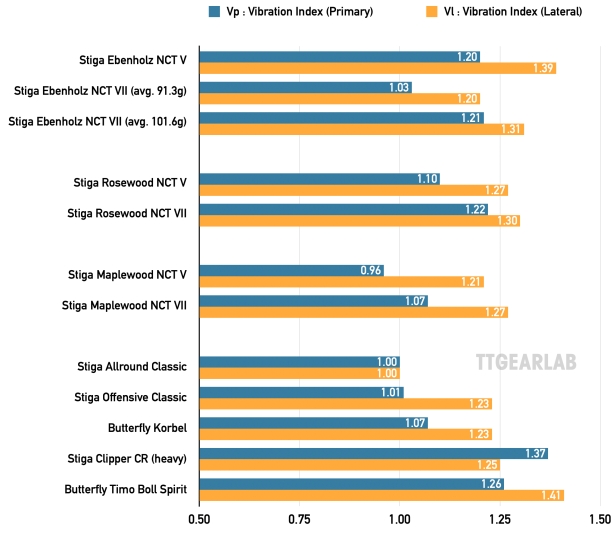
Vp – Primary Vibration Index – of Ebenholz NCT V is 1.20, and is higher than that of other 5-ply blades – the other NCT V blades, Allround Classic, Offensive Classic and Korbel – in this comparison. I.e. the primary feeling of Ebenholz NCT V is harder or sharper than that of usual 5-ply wood blades. Vl of Ebenholz NCT V is also relatively high. And, Vl is higher than Vp. It means that the feeling at the fingertip of index finger is very sharp. This characteristic is similar not to that of Stiga Allround Classic but to that of Offensive Classic, although both of Vp and Vl of Ebenholz NCT V are much higher than those of Offensive Classic. We can regard Ebenholz NCT V as the harder version of Stiga Offensive Classic. Interestingly, the Vp and the Vl of light Ebenholz NCT VII (avg. 91.3g) are very close to those of Offensive Classic or Korbel. Light Ebenholz NCT VII is as soft as Offensive Classic or Korbel. But, heavy Ebenholz NCT VII (avg. 101.6g) is much harder than Offensive Classic.
The Vp and Vl of Rosewood NCT V are similar to those of Korbel. That is the same case as we see from Ep and Ec of Rosewood NCT V. So we can conclude that Rosewood NCT V is totally similar to Korbel. Although there should be the difference of detailed feeling due to the difference of the kind of wood, overall mechanical characteristics of Rosewood NCT V are very close to those of Korbel. On the contrary, Rosewood NCT VII is totally different from Clipper CR when we observe Vibration Indices, while we have already observed that Rosewood NCT VII shows the same tendency of Elasticity Indices as the tendency of Clipper CR. Vp and Vl of Rosewood NCT VII are similar to those of heavy Ebenholz NCT VII. The primary vibration of Rosewood NCT VII are much stronger than that of Rosewood NCT V. But, the lateral vibration of Rosewood NCT VII felt at index finger is almost the same level as that of Rosewood NCT V. For that reason Rosewood NCT VII shows relatively uniform characteristics of vibration.
Both of Maplewood NCT V and Maplewood NCT VII show very low values of Vp. On the contrary both of those two show relatively high values of Vl. It means that the feeling at index finger is very clear and sharp while the primary feeling felt at our palm is soft or comfort. From the viewpoint of vibration, Maplewood NCT V is close to Offensive Classic, and Maplewood NCT VII is close to Korbel.
The feeling of six Hardwood blades is similar to that of Korbel or Timo Boll Spirit. But, not any model of Hardwood blade shows similar feeling as Stiga Clipper which is an orthodox 7-ply wood blade.
3. CONCLUSION
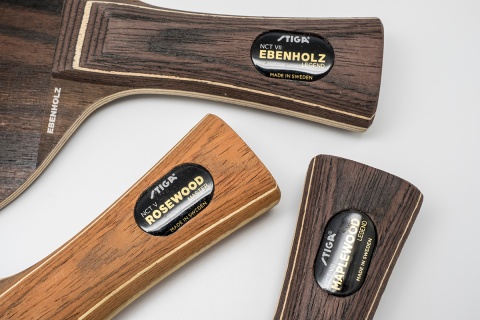
The result of comparison can be summarized as follows:
- Ebenholz NCT V is keeping the basic characteristics of Stiga Offensive Classic, but is faster and harder than Offensive Classic.
- Light Ebenholz NCT VII (around 90g) is very close to Butterfly Korbel, and heavy Ebenholz NCT VII(aroud 100g) is very close to Butterfly Timo Boll Spirit. So they can be the alternative of those Butterfly blades if the difference of shape, thickness or weight will not be a problem.
- Rosewood NCT V shows very common characteristics of standard offensive 5-ply wood blade. Especially it is somewhat close to Butterfly Korbel. It can be the alternative of Butterfly Korbel if the difference of shape will not be a problem.
- Rosewood NCT VII is slower and softer than Stiga Clipper. And, it provides more uniform feeling.
- Maplewood NCT V is very soft and holds ball very deep. And the feeling at index finger is very sharp and clear. Its characteristics are more extreme than what we can expect from common 5-ply wood offensive blade such as Korbel.
- Maplewood NCT VII is similar to Maplewood NCT V. But, it is a bit faster and harder than Maplewood NCT V.
Each model of Hardwood series can be recommended as follows :
- In case player doesn’t have any preference : Rosewood NCT V or Light Ebenholz NCT VII
- For modern offensive style by topspin from both hands : Rosewood NCT V, Ebenholz NCT VII, (Maplewood NCT VII)
- Close-to-table topspin : Rosewood NCT V, Ebenholz NCT V, Ebenholz NCT VII, (Maplewood NCT V)
- Classic topspin from mid-distance area : Light Ebenholz NCT VII
- Fast attack with smash and block : Rosewood NCT VII
- Modern all-round style : Ebenholz NCT V, Rosewood NCT VII
- In case player lays the most emphasis on speed : Rosewood NCT VII or heavy Ebenholz NCT VII
Note : Recommendation is based on my experience of the comparison. Please don’t 100% believe this information, and just use it for reference, because the actual result may differ by your own situation.
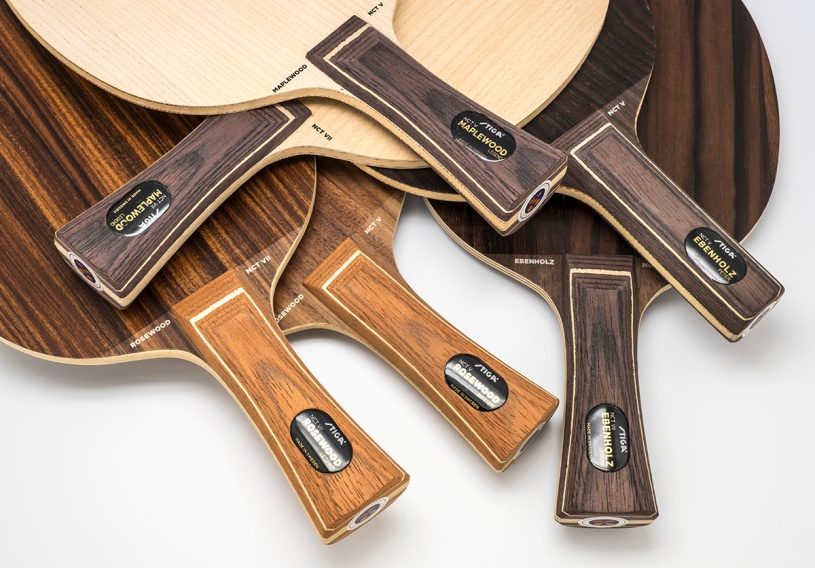
Hello! First respect for your blog, fine thing that you do there. Question: I would like to change from the Boll Spirit although I love the gameplay characteristics for different reasons to a Stiga blade. To which would you advise me? Carbonardo 190/145/90/45, Ebenholz VII or another? Thank you for your answer! Cheers Kevin
LikeLike
Hello! First respect for your blog, fine thing that you do there. Question: I would like to change from the Boll Spirit although I love the gameplay characteristics for different reasons to a Stiga blade. To which would you advise me? Carbonardo (190,90,145…., Ebenholz VII or another? Thank you for your
answer! Cheers Cave
LikeLike
Thank you for reading my posting. If you want to select one model of Carbonado series to replace Timo Boll Spirit, I recommend Carbonado 190.
Its overall characteristics is quite similar to that of Timo Boll Spirit although not perfectly same.
LikeLike
Hi . First many thanks for these professional explanations and tests.
I have only one question:
How could the Stiga Clipper CR (7 Wood layers-surface treatment ) be much faster than the Stiga Clipper CC as seen in many of your tests if Stiga itself says the CC Version (6 carbon powder layers +7 Wood layers ) is faster. This is quite irritating because i wanted to buy the CC Version because its the fastest of the Clipper series according to stiga website. Due to the carbon in the CC this makes sense actually.
Please check the speed and control values of both blades on stiga website and you will see this.
How do you explain this?
Many thanks, Soltis
LikeLike
Thank you for comment. I’m not sure whether Clipper CC has the layers of carbon powder or not. But, it is apparent that ‘carbon powder’ doesn’t have any meaning on performance. Maybe there is very tiny effect. But, it doesn’t make meaningful difference. ‘6 carbon powder layers + 7 Wood layers’ is not much different from normal 7 Wood layers.
Powder can’t resist tensile force or compressive force. That is the reason why it can’t affect the performance of blade. It doesn’t make sense.
In fact there is a factor that powder material is meaningful. The change of the internal structure of dried adhesive may decrease the structural damping due to adhesive. Then the energy loss during impact period is a bit reduced. In that case there is the increase of performance.
However, the improvement of performance through that approach is not significant. And, it doesn’t affect the stiffness of blade at all. The difference of stiffness between Clipper CR and Clipper CC is too big because Clipper CR is much thicker than Clipper CR.
Please just think Clipper CC as a relatively thin 7-ply wood blade. You’d better forget any powder material when you think about performance.
LikeLike
Thank you for the detailed explanations.
But this would mean that the classification of Stiga and the values they gave to both blades are wrong since the classified the CC as faster than the CR.
CC:
Technologies Crystal Technology, NCT
Veneer: 7+6
Control: 62
Speed: 118
CR:
Technologies: CR
Veneer: 7
Control: 64
Speed: 112
LikeLike
In many cases the values suggested by makers are not correct. I recommend you not to believe those values. 🙂
Definitely CR is much faster than CC.
LikeLike
Hello again. Now tabletennis rubbers are so fast. Stiga DNA Hard and Andro Rasanter R53 and so on. Ihave bought Stiga Maplewood VII. This blade holds the bal so deep when hitting hard. So i guess i must try and order Maplewood V. The reason. The ball shots off in a big way when hitting hard. Semms to be too much catapult when hitting hard. Anyway the blade gives very much spin in serves and brush loop. Do you agree with going for slower Maple wood V? Have had the chance to try out Stiga DNA Hard yet? Thanks for your amazing knowledge and time used.
LikeLike
In fact there isn’t solution that is always correct. Therefore I can’t easily predict the result. But, in my opinion, the catapult of MapleWood V is not that different from that of MapleWood VII. MapleWood V is slower (= less elastic) than MapleWood VII. However, speed difference is the only one difference between those two. Those two share all the other factors.
By the way, DNA Pro H is not elastic when you hit the ball in close to normal direction. DNA Pro H makes ver fast ball only when you put big amount of rotation to the ball. For that reason, the primary elasticity of blade is not that important when you use DNA Pro H. DNA Pro H will be significantly different from Rasanter R53.
LikeLike
Hello.
Thanks for answering. I have my two Maplewood V now. What a blade. It works extremely well with hard rubbers. Maybe now i can use Tibhar MX-S, and it will work out well. I guess MX-S is one of the best spin rubbers. Even better than Tenergy 05.
Thanks for all your effort.
LikeLike
Thank you for share your experience. I think that MX-S will make good harmony with MapleWood V especially in feeling. MapleWood V is very soft, and MX-S is somewhat hard. Somewhat extreme characteristics of those two are neutralized when combined.
LikeLike
Can u compare with andro gauzy sl or cornelieu absolum (7 ply , ebony surface) tks
LikeLike
I’m sorry but I couldn’t have got those blades. I will try if I can get samples.
LikeLike
Hello,
I wonder how the Yasaka Goiabao would compare to some of stigas hardwood blades.Do you have any samples?Thanks
LikeLike
I’m sorry but I don’t have that model.
If I can get a sample, I will write the date in future article.
LikeLike
Amazing comparison, and the only one I could find that directly compares these 2 blades (Rosewood vs Ebenholz).
My local shop is offering three blades at 50% discount:
Stiga Rosewood NCT VII (89 gram)
Stiga Ebenholz V (91 gram)
Stiga Emerald VSP V (94 gram)
As a player that likes to open the rally with a loop and is somewhat of an “all-round/offensive” player. What would you recommend for me to buy out of these 3 options?
I am currently using medium/hard rubbers on an Stiga Allround Classic blade, and am looking for a somewhat faster blade that still gives me control/feel. Basically I want the “least” fast option out of these 3 with the most “dwell time”. And I was wondering if weight plays a big factor here too.
I hope you are able to answer this question, thanks a lot for the review 🙂
LikeLike
Thank you for comment. And, I’m sorry for late reply due to my personal condition.
If you have been using Allround Classic, there isn’t any blade that I can recommend among those three. Most of all, those three has hard top layers. And, those are much faster than Allround Classic. Ebenholz V is the slowest one among those three. But, its feeling will be too different from Allround Classic.
LikeLike
Thank you so much for this website. It has really opened my eyes that an all-wood blade can perform like an outer-layer carbon blade like Timo Boll Spirit/ALC. It has also shown me that blades can have very different behavior even with the same construction. I can stop wasting money on “clone” blades!
LikeLike